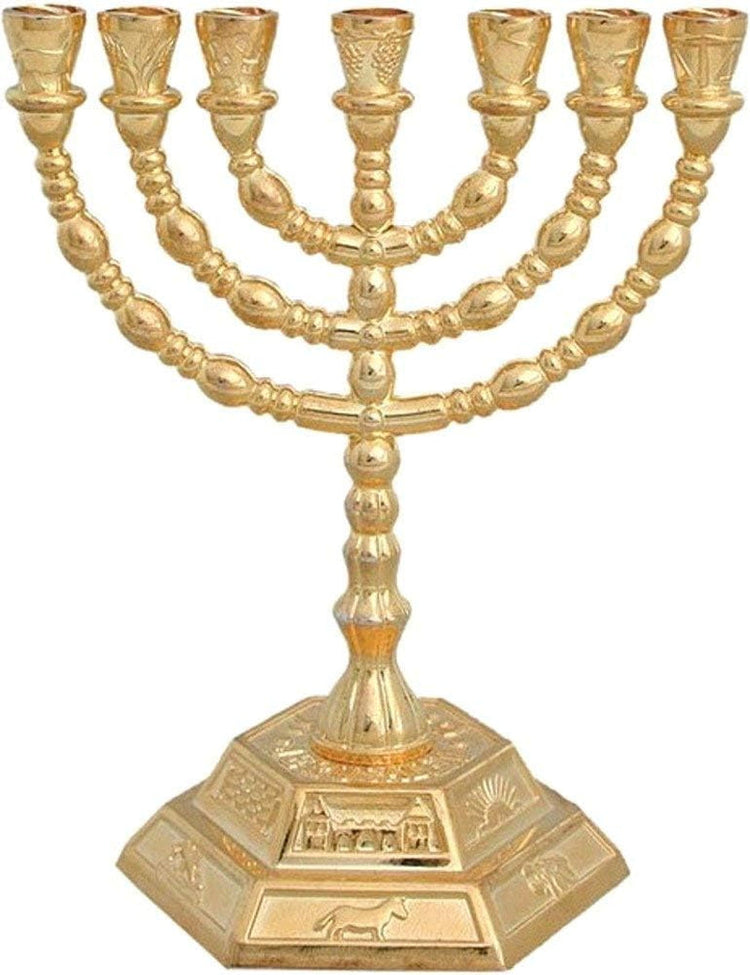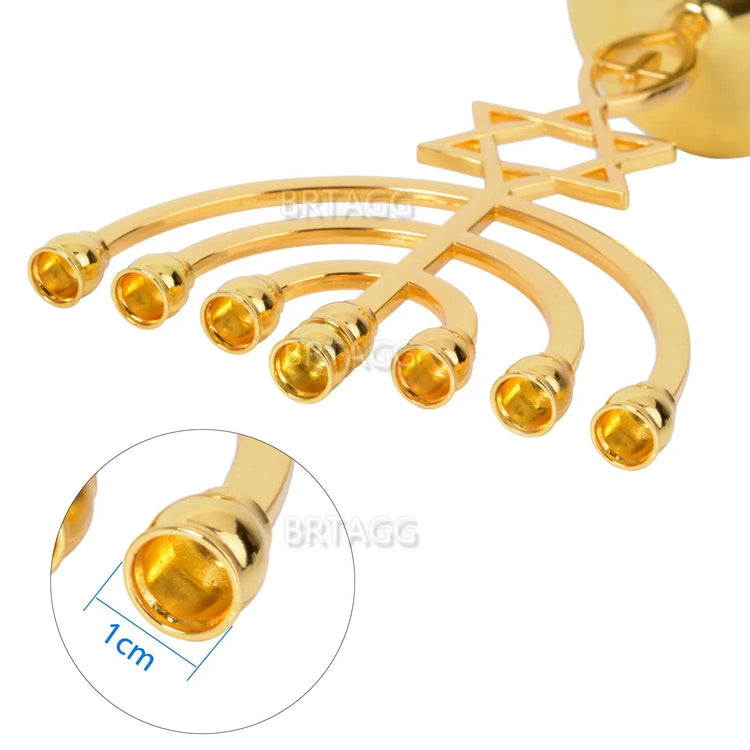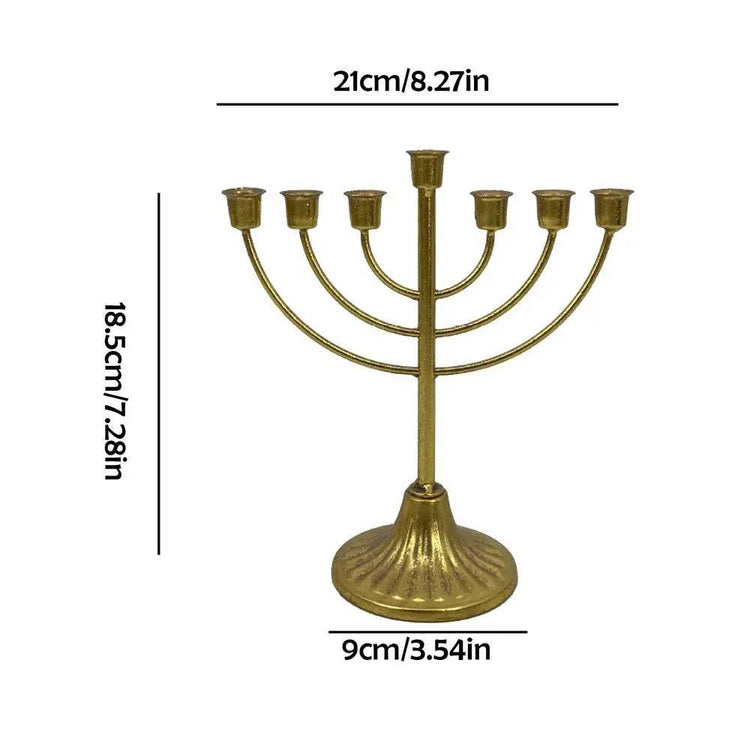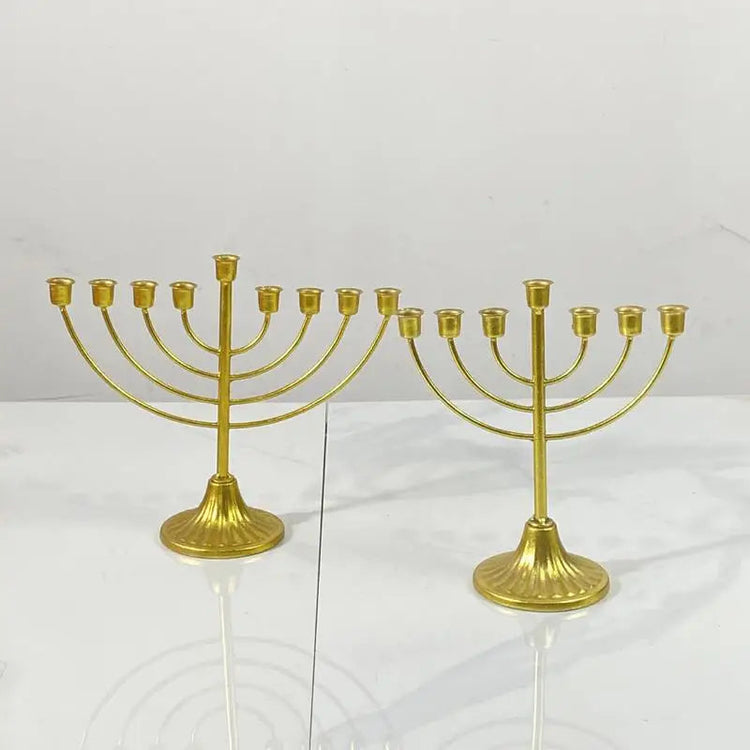Jewish Menorah 7 Branch - 12 Tribes of Israel, Gold, 5 in - Hanukkah Tabletop Candle Holder
- Regular price
-
$20.09 - Regular price
-
$0.00 - Sale price
-
$20.09
-
Hurry, only 10 items left in stock!
Couldn't load pickup availability
Shipping information
Use collapsible tabs for more detailed information that will help customers make a purchasing decision.
Ex: Shipping and return policies, size guides, and other common questions.
Returns information
Use collapsible tabs for more detailed information that will help customers make a purchasing decision.
Ex: Shipping and return policies, size guides, and other common questions.




Product Details
- SEVEN BRANCH DESIGN: Features a seven branch menorah with symbols of the 12 tribes of Israel. Perfect for those seeking a menorah gold 7 branch for their collection.
- HEXAGONAL BASE: Sits on a sturdy hexagonal base showcasing the 12 tribes of Israel symbols. Ideal for those looking for a menorah 7 branch candle holder.
- MODERN SYMBOLISM: Represents one of the modern symbols of Israel. A great addition for those interested in a 7 branch menorah tree of life gold.
- GIFT OR DECOR: Makes a great gift idea or house decoration. Suitable for those searching for a hanukkah candle holder for menorah.
- QUALITY MATERIAL: Made from durable alloy steel with a gold finish. Perfect for those seeking a menorah gold 7 sticks for tabletop display.
Product Description
A BIT ABOUT US
We understand the importance of faith and family, and that is a core value that we apply to every aspect of our business. We started the Holy Land Market as a family business in 2001, and have grown as a company and family since then. As a family of strong faith, our primary goal when starting out was to support the locals in the Holy Land, and that’s still our main focus today.
We’re proud to offer the largest collection of authentic items from the Holy Land to customers like you. Our items are handmade by only the most experienced artisans in various cities. They understand the importance of crafting every item with care and love.
ORIGIN AND TRADITION
One of the most recognizable symbols in all religions is the Jewish Menorah. The branches are easy to identify, and their history and story are told every year at family and religious gatherings. They are made out of a variety of materials including olive wood, but each one is built to last for decades. If you are unaware of the history, it’s encouraged that you research the available information that not only breaks down their meaning but the significance of each kind of Menorah. Yes, there are different types, most notably the Hanukkah Menorah.
Learning about the history and significance of this religious artifact brings you closer to the faith. Knowing that for thousands of years these artifacts have told such a unique and rich history makes the stories even more significant. Here are some of the basics about their history that you should know.
Origin
The Jewish Menorah is first mentioned in the bible in Exodus: Chapter 25. They were built in Temples and every night the priests would light them during services and clean them every morning, replacing the oil and wicks that had burned away. After the destruction of Temples, the Jewish Menorah was no longer made for years out of fear of persecution. However, new designs with one fewer candle were crafted to replace the original design. This type has been used for centuries but in modern times you can find different rabbis using different options including the original seven-branched menorah.
Tradition
Menorah is actually the Hebrew word for “lamp.” That’s significant because its original use was for light. Now, the artifact is more often seen during holidays, it has become a symbol of Hanukkah. However, the true story behind it is that it was used daily for people who were attending service and praying.
As we learn more about this unique item, we also seek out some of the unique stories behind it. Who can imagine an artifact being banned from use for years, only to be transformed into one of the most symbolic and well-known religious symbols in the world today. The true story about the artifact is about faith and commitment. Rather than having the idea of the Menorah fade out, it now stands stronger and more identifiable than ever before.
FIVE INTERESTING FACTS ABOUT MENORAHS
1. The Hanukkah Lamp or Temple Menorah?
While the Hanukkah lamp (which has nine branches) is inspired by the temple menorah, they are not technically the same exact thing. The menorah has seven branches and was the candelabrum used in The Holy Temple in Jerusalem (and prior to that, the Tabernacle). The Temple menorah was crafted of pure gold and held the oil that miraculously lasted for eight days. This, in turn, inspired Hanukkah, with two additional branches added to the Hanukkah lamp (one for each night, and an extra candle to light the others). So even though they are symbolically related, the Hanukkah lamp and the Temple menorah are technically different.
2. Candles Aren’t Required
This might be a surprising entry since the menorah is most frequently depicted as having candles within its branches. However, there are menorahs that are crafted with places you can put not only candles but oil. The Temple menorah was traditionally fueled by olive oil (this was the very oil that miraculously burned for eight days). For this reason, some customs favor olive oil over candles, especially for personal use, with candles sometimes favored for the synagogue’s menorah.
3. Windows and Doorways are Important
In more ancient times, many houses were built to face courtyards. When this was the case, it was tradition to ensure the menorah was at the courtyard entrance. It was typically placed on the left of the entrance, with the mezuzah being on the right. Some say that the placement of these two icons on the right and left created what is known as a mitzvah-filled portal. Eventually, the menorah’s placement moved indoors, but many still prefer to put it at a window (though some still light it inside of their doorways like the courtyard entrances of old).
4. The Time the Candles Should Be Lit
It is a common custom that the candles of the menorah be light at a specific time: shortly after the sun sets. There are other communities that light their menorahs more specifically closer to 30 minutes after sunset, however. The exception to this rule is on Friday, when the menorah should be lit before the Shabbat candles and before sunset, and on Saturday night it is lit after nightfall. That all applies to personal menorahs. For a menorah at a synagogue, they must to be lit before sunset in accordance to when the Temple menorah was historically lit.
5. Specific Blessings and Prayers Should Be Said
Two blessings should be said before the menorah is lit. The first thanking God specifically for the mitzvah of the menorah, and the second should speak tribute and recognize His miracles. Additionally, before the first lighting of the menorah every year, thanks for the opportunity to celebrate Hanukkah should be offered up by saying the shehecheyanu.








